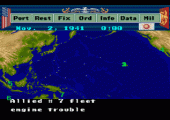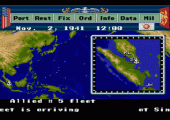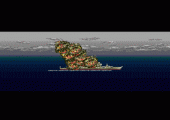Genre: Strategy Developer: KOEI Publisher: KOEI Players: 1 Released: 1993
When it comes to old-school strategy games, Koei was the king, producing several for the Sega Genesis console in a variety of settings. P.T.O. puts you in the boots of a leader commanding the naval operations of either the U.S. or Japan during World War II. You will take bases by land, sea, or air, supply troops and weapons, build warships, haggle with the government, persuade leaders, and overall change the course of the war that explodes between the Axis and Allies. There is no shortage of responsibilities and options in this game, and it will test your limits if you want to achieve victory.
To start, you are dropped into a map of the Pacific with several menus and left to your devices. It was here that I initially fooled around with some options and then shut the game off, deeming it inscrutable. A manual or guide is essential to making any progress in the game, and thankfully, there are a handful of helpful resources around the web to walk new players through the wide array of duties to attend to. Studying up on the various menus and submenus will pay dividends later on, as making mistakes early on will damage you later in the game. The control layouts on these types of ports are always where the big issues arise. When being ported onto consoles, developers would be forced to compress the vast array of options into a series of menu screens. That is the lamentable case here, but once a player becomes comfortable with the menu scrolling this becomes less of an issue.
After selecting your difficulty, you’re given the option to roll up stats for the twenty generals who you will guide through the war, each with his own benefits and downfalls. From there, you’ll be viewing the main map, which shows the fifty bases spread from America to Asia. In order to win the main campaign, your objective will be to either occupy every base or destroy every enemy fleet; no prisoners will be taken. The game clock counts in military time, and you can take an action every four hours. The pace will be slowed down by numerous reports that scroll the bottom screen as well as battle reports if you choose to automate battles.
If you choose to view battles, whenever fighting is initiated, you will be taken to a separate battle screen and given the option to maneuver your units. Whenever combat starts, a split-screen cut scene plays, showing your tanks and infantry duking it out with the enemy, blue versus red, with numbers indicating how many units are left. It’s well animated and looks great, but if there are many units, these real-time battles can take a long time to play out. Thankfully, the developers offered the option to let these battles play out off-screen, with post-fight reports able to be viewed showing success or failure and number of casualties. If you really want to dig in to the strategy at both macro and micro level, then the option is there for you, but if you just want to delegate through the already-long campaigns, you can easily turn these battle animations off and still get a lot out of the game.
Visually, there is not much to look at. You’ll either be staring at the same map of the Pacific Ocean for the majority of the game, watching your fleets crossing the waters, or you’ll be navigating the menu screens of numbers and icons. There are a few static screens whenever enemy planes approach or you begin a ground invasion, and the faces of your generals are pretty well-done. It’s not an ugly game by any means, but the sprite work was not the highest priority nor should it have been. Musically, P.T.O. is entirely competent. The main themes are nicely done, although like any song, after listening to the same notes for the many hours it takes to beat the game, they will grow tiresome. I chose to mute the TV and queue up some epic pirate adventure music on YouTube, and it enhanced my enjoyment of the battles immensely.
P.T.O. does a wonderful job of dropping the player into the action and replicating the feel of becoming a general and changing the course of war. The attention to historical detail elevates this game and the deep gameplay options allow for a high level of replayability. In addition to the main campaign, there are eight additional ones, recreating key battles of the Pacific Theater such as the attack on Pearl Harbor and the Battle of Midway. These give additional quests onto the main game.
The main issue with old strategy games such as this is accessibility. In order to even understand how to proceed, the player will have to devote a significant amount of time reading the manual cover to cover while also seeking out online playthroughs and supplemental guides in order to breach the surface. It will take longer than that before the first victory is won and progress is achieved, and much time before the end, although once the main commands are understood, it becomes second nature. It’s understandable that many modern players do not want to have to study how to play a game for hours before being able to make progress, but retro gamers should know what to expect when seeking out a game of this genre – deep strategic combat that tests foresight, patience, and decision-making. If you’re ready for it, there are many, many hours of gameplay available here. P.T.O. deserves high marks for being another shining example of an amazing strategy game.
SCORE: 8 out of 10










Recent Comments